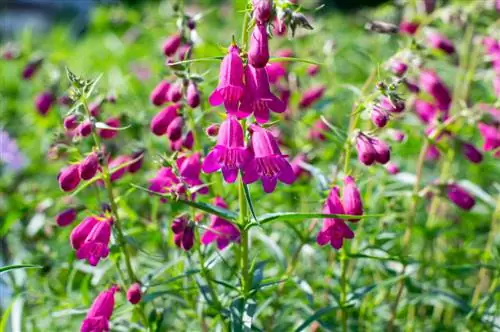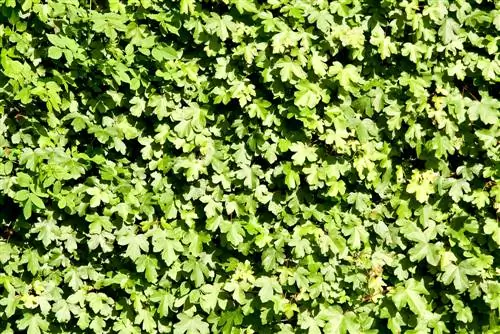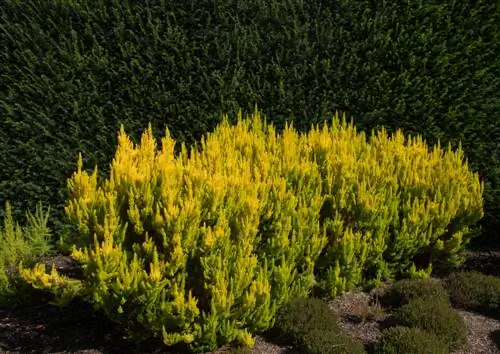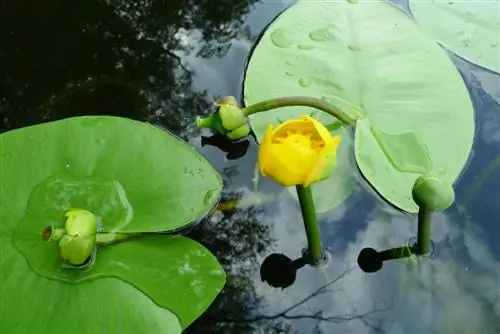- Author admin [email protected].
- Public 2023-12-25 17:45.
- Last modified 2025-01-23 11:21.
The penstemon, which looks very similar to foxglove, is an undemanding and easy-care perennial that shines in the garden both as an eye-catcher in beds and borders and as a valued species of bees and insects. The large flowers and bright colors appear from June and, with good care, well into autumn.

What are the special features and care requirements of the beard thread?
The penstemon (Penstemon) is an easy-care perennial with showy flowers that bloom from June to autumn. It prefers a sunny, warm location and humus-rich, well-drained soil. The plant is non-toxic and is suitable for beds, borders and as insect pasture.
Origin and distribution
The penstemon (bot. Penstemon) is an attractive genus of flowering plants from the plantain family (bot. Plantaginaceae). Around 250 different species belong to this genus, most of which are herbaceous or woody. Beards, which are perennials, originally come from the warm regions of North America and Mexico, where the plants thrive perennially. However, under the influence of the Central European weather, the cold and moisture-sensitive plants are not winter hardy and are therefore usually maintained as annuals. However, it is occasionally possible to get some more robust species and varieties through the cold season with the help of good winter protection.
Usage
The colorful flowers as well as the tall and slender growth make the penstemon appear as the perfect companion and decorative plant in perennial and summer flower beds as well as in borders. Its possible uses are enormous, after all, the numerous single and multi-colored varieties offer a large selection. The penstemon looks particularly attractive together with other perennials such as summer aster (Callistephus), gypsophila (Gypsophila), delphinium (Delphinium) or chrysanthemums. Low-growing species find a popular place in a stone or gravel garden, and some also feel very comfortable as potted plants on balconies and terraces. Large-flowered varieties - which are particularly found in hybrids - also produce long-lasting cut flowers.
Appearance and growth
Depending on the type and variety, the penstemon reaches heights of between 40 and 80 centimeters. The forms we cultivate usually have a herbaceous habit; only a few species grow as subshrubs or shrubs. The stems of the penstemon strive upright and are densely covered with narrow, lanceolate leaves. These are usually arranged opposite each other. The leaf edge is either smooth or serrated.
Bloom and flowering time
The delicate flowers are similar in structure to those of the foxglove. They are bell-shaped or tubular and sit either in terminal clusters or panicles. Each flower has five stamens, one of which is always covered with long hairs - this characteristic gives the genus its peculiar name. The penstemon blooms in many bright colors: white, pink, red and even violet tones bring magnificent splashes of color to the garden bed. The flowering period usually extends between May and August, although with good care and in a suitable location the penstemon can bloom well into autumn.
After flowering, brown capsule fruits containing angular seeds will develop until autumn, unless pruned.
Toxicity
In contrast to the externally quite similar foxglove (bot. digitalis), penstemon is non-toxic and therefore perfect for cultivation in family gardens. However, both species belong to the plantain family (bot. Plantaginaceae).
Which location is suitable?
The penstemon feels most comfortable in a sunny, warm and protected location. Not only does it bloom more beautifully the more intensely the sun shines: it also needs good protection from wind, otherwise the flower-bearing stems can bend or break off. A spot directly in front of a light-colored wall or house wall or a hedge that doesn't cast shadows is ideal. In regions with mild winters (for example in wine-growing regions), the penstemon can overwinter well protected outdoors, in all others you should either only care for it as an annual or overwinter it frost-free. The plant can tolerate slight frost down to around minus five degrees Celsius.
Soil / Substrate
Plant the penstemon in humus- and nutrient-rich soil that should be as fresh and well-drained as possible. The plant is very sensitive to waterlogging, which can be a problem, especially in winter. It is therefore essential to ensure good drainage both in the bed and in a pot culture so that excess water can flow away quickly. When overwintering outdoors, the beard must be protected from moisture and moisture. In terms of the optimal pH value, the plants prefer neutral to slightly acidic soil. Before planting, enhance this with plenty of compost and, if necessary - if the substrate is comparatively heavy - with coarse sand.
For potted specimens, we recommend using high-quality compost-based plant or potting soil, which you can add perlite, expanded clay or sand to improve permeability. In addition, the planter must have drainage holes at the bottom so that the beard does not have to stand in the wet if it spills too much from the watering can.
Planting penstemon correctly
Prefer the summer bloomers on the windowsill from February. The young plants will move into the garden bed or onto the balcony from May onwards, although you should definitely wait for the ice saints to arrive. Otherwise, late frosts could quickly ruin your plants. Before planting, prepare the soil well:
- Loose the ground and remove stones and weeds.
- Make a planting plan where which perennials and flowers belong.
- Observe the recommended planting distances.
- Now dig the planting holes, which should be about twice the size of the root ball.
- Mix the excavated material with compost and horn shavings.
- You can also mix in a long-term fertilizer for flowering plants.
- Lift the beard out of the pot and gently loosen the roots with your fingers.
- Insert the plants and fill in the substrate.
- Press the soil firmly and water the plant well.
Tall varieties should also be provided with a support rod when planting so that they do not bend.
Planting spacing
Depending on the species and variety, a planting distance of between 20 and 30 centimeters is recommended.
Planting time
Don't plant the penstemon outdoors until after the Ice Saints in May.
Watering and fertilizing
Basically, the penstemon is a fairly easy-care summer flower that only gets along well with a little water and occasional fertilization. Planted specimens actually only need to be watered in dry phases and in hot weather, whereas you should water penstemon cultivated in a pot moderately. Before each watering, do a finger test so that you can estimate the actual water requirement. Basically, strong-flowering and tall-growing varieties require more moisture than the low-growing varieties.
While short penstemon varieties also do very well on rather poor soils and only need a little fertilizer, you should supply the tall varieties with a liquid fertilizer for flowering plants from time to time. However, only start fertilizing six to eight weeks after planting, provided you have already added compost, horn shavings or even a slow-release fertilizer.
Cut the beard correctly
Remove the dead shoots regularly so that the penstemon keeps producing new flowers. However, you can leave one or two flowers standing for the purpose of collecting seeds. Then just make sure to collect the seed capsules in good time before they burst.read more
Multiply beard
Most penstemon species and varieties can be easily propagated from cuttings cut in summer, although these must be kept frost-free over the winter. Propagation via seeds is also easy, although not all commercially available varieties can be used to obtain germinable seeds - most of them are non-fertile hybrids. However, you can choose seed-resistant variants as follows:
- Fill a growing tray with low-nutrient growing substrate.
- Sow the seeds and press them lightly into the substrate.
- Spray the substrate with water and moisten it slightly.
- Cover the bowl with cling film or a translucent hood.
- Place the bowl at 18 to 20 °C, quite warm and bright.
- Aerate daily and keep the substrate slightly moist.
After about three weeks, the young plants germinate and are then pricked out as early as possible - otherwise they could grow too long and collapse. Cultivate the young beard threads in a cool place at around 12 to 15 °C.
Furthermore, some species of penstemon can be divided as long as you cultivate them for several years and overwinter accordingly.
Wintering
With a bit of luck, some robust varieties of penstemon can overwinter in the garden bed. To do this, you should cut the plants back in autumn and cover them with fir or spruce branches. However, if you actually want to overwinter the summer flowers, it is better to dig them up, plant them in a pot and overwinter them brightly, coolly and frost-free. The easiest way, however, is to dispose of this year's plants and grow new ones from (self-collected) seeds starting in February.read more
Diseases and pests
Pests and diseases rarely occur on penstemon. The only problems that could be problematic are aphids and nematodes; snails also often like to eat the plant. Powdery mildew can also occur, but it can be treated quite easily with a mixture of water and whole milk that you spray on diseased plants. Wilt disease, on the other hand, is more difficult and cannot be treated in most cases. It occurs when the penstemon is permanently in soil that is too moist and the roots therefore rot.
Tip
If you want to cut some of the penstemon's flower stalks as cut flowers for the vase, it's best to do this early in the morning - then experience shows that the flowers last the longest. Place the flower shoots in a clean vase with fresh water and place them in a bright and not too warm place. It is best to change the water daily.
Species and varieties
The varieties available commercially are almost exclusively hybrid forms, although some of them look very similar to their parents and can therefore hardly be distinguished from them. Some pretty shapes for the home garden include:
- Penstemon barbatus 'Coccineus': up to 120 centimeters high, bell-shaped, bright red flowers
- Penstemon barbatus 'Praecox Nanus Rondo': bushy growth, height up to 40 centimeters
- Penstemon digitalis 'Dark Towers': clumpy growth, height up to 90 centimeters, violet-pink flowers with white tips
- Penstemon digitalis 'Husker's Red': clump-forming, growth height up to 100 centimeters, large, white flowers arranged in panicles
- Penstemon scouleri 'Catherine de la Mare': upright growth, height up to 40 centimeters, azure flowers arranged in clusters
- Penstemon hartwegii 'Picotee Red': blooms bright red
- Penstemon hartwegii 'Schönholzeri': flowers strikingly scarlet






